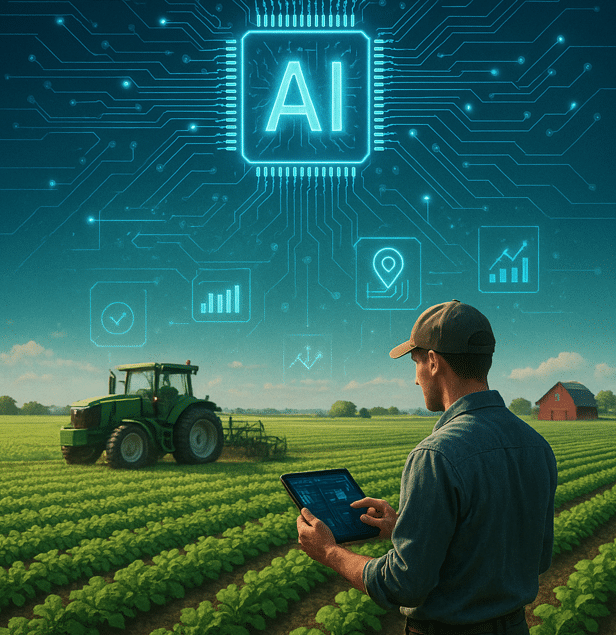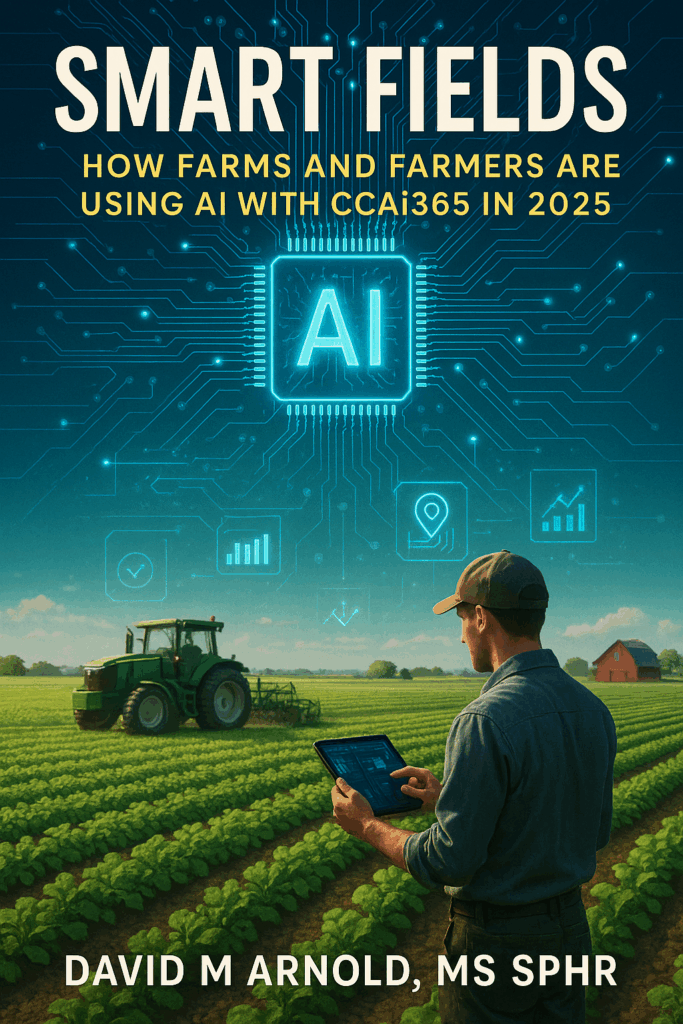Introduction to AI in Farming
In the not-so-distant past, farming relied heavily on manual labor, instinct, and traditional practices passed down through generations. But today, a new wave of innovation is sweeping across fields, orchards, and greenhouses — and it’s powered by artificial intelligence. That’s right: AI in farming is not just a futuristic concept anymore. It’s happening now, and it’s transforming the agricultural landscape in ways we’ve never imagined.
Whether you’re running a small organic farm or managing thousands of acres, AI is helping farmers achieve better crop yields, reduce costs, make smarter decisions, and prepare for the challenges of tomorrow. In this article, we’ll explore the top 5 game-changing ways AI in farming is supercharging your crops. From data-driven insights to drone-powered precision, it’s time to embrace the smart side of agriculture.
The Cutting-Edge Tech Behind AI in Farming Today
AI in farming isn’t just about automation — it’s about smart automation. Behind the scenes, a powerful ecosystem of technology is making it all possible. We’re talking about cloud computing, edge devices, machine learning algorithms, IoT (Internet of Things) sensors, and advanced analytics tools. These technologies combine to give farmers real-time insight into everything from soil conditions to crop health and pest activity.
One of the core technologies fueling AI in farming is the smart sensor. These tiny devices are embedded in the soil, attached to irrigation systems, or mounted on equipment to continuously collect data on temperature, moisture levels, pH, nutrient availability, and more. This data is sent to a centralized AI system, which analyzes it instantly to deliver actionable recommendations.
Another major component is connectivity. With the rise of 5G and satellite internet, even remote farms can now stay connected. This connectivity enables AI-powered platforms to receive and process information in real-time, ensuring that no issue goes unnoticed.
AI in farming also benefits from predictive analytics. Using historical data and current trends, AI tools can forecast crop yields, predict pest outbreaks, and optimize planting and harvesting schedules. This means you can plant smarter, irrigate efficiently, and manage resources like never before.
Moreover, digital twins are emerging as a revolutionary concept in farming. A digital twin is a virtual model of your farm that mirrors real-time conditions and enables simulation-based decision-making. Want to know what would happen if you adjusted your watering schedule by a day? Your AI-powered digital twin can tell you.
In short, AI in farming is built on a robust and rapidly advancing tech foundation. As these tools become more accessible and affordable, they’re setting a new standard for agricultural excellence.
Download your Free eBook Today!
How AI in Farming Uses Data to Drive Crop Success
Data is the lifeblood of modern agriculture, and AI in farming knows how to make the most of it. Traditional farming often relied on seasonal observations and gut feelings. Today, AI platforms are capturing, analyzing, and acting on millions of data points — in real-time.
AI in farming uses historical yield data, weather patterns, soil profiles, pest activity logs, and more to identify patterns that even experienced farmers might miss. For example, if a particular corner of a field consistently underperforms, AI can pinpoint the root cause — whether it’s soil nutrient deficiency, inadequate irrigation, or pest presence.
Precision agriculture is a prime example of data-driven farming in action. AI systems integrate GPS mapping, soil data, and yield monitoring to create tailored planting and treatment strategies for each part of the field. Instead of applying the same amount of fertilizer across an entire area, farmers can target specific zones, reducing waste and maximizing results.
Another benefit of AI in farming is real-time alert systems. Farmers are immediately notified if weather conditions change, if a pest outbreak is detected, or if an irrigation malfunction occurs. This responsiveness helps prevent crop loss and ensures timely intervention.
AI in farming also plays a role in market intelligence. By tracking commodity prices, supply chain trends, and consumer demand, AI tools can suggest the best time to harvest or sell produce. This level of insight empowers farmers to make smarter business decisions.
Ultimately, AI transforms data into wisdom. By leveraging advanced analytics and machine learning, AI in farming allows you to continuously improve crop performance, year after year.
Satellite Imaging and Drones: AI in Farming from Above
It’s a bird. It’s a plane. Nope—it’s an AI-powered drone giving you a bird’s eye view of your farm! One of the most exciting developments in AI in farming is the integration of aerial technology. Both satellite imaging and drones offer unprecedented visibility into crop health, soil conditions, and more.
Drones equipped with multispectral cameras can scan large areas of farmland in minutes. These drones collect high-resolution images that are then processed by AI systems to detect plant stress, disease, weed growth, or water issues — often before they’re visible to the naked eye.
AI in farming uses satellite imaging to provide macro-level insights. These images, captured over time, allow AI to monitor seasonal changes, assess overall crop health, and evaluate land usage patterns. This holistic view is particularly helpful for large-scale farms or those managing diverse crops across multiple plots.
AI-powered drones can also help with crop spraying. Unlike traditional methods that blanket the entire field, drones can target specific areas that need treatment, reducing chemical use and costs.
The real magic happens when aerial imagery is combined with other farm data. AI systems overlay aerial images with sensor data, historical yields, and environmental conditions to create comprehensive field maps and action plans.
This top-down approach ensures nothing is missed. If there’s a nutrient deficiency in one section or water pooling in another, AI in farming can detect it and recommend precise solutions. Farmers no longer need to rely solely on ground-based inspections — the sky is literally the limit.
Machine Learning and Robotics: The New Face of AI in Farming
Robots in the field might sound like science fiction, but AI in farming has made them a reality. Machine learning — a key branch of AI — is driving the development of smart machines that can perform complex tasks with speed and accuracy.
Today’s AI-driven robots can plant seeds, weed crops, harvest produce, and even sort fruits based on ripeness. These machines are equipped with advanced sensors and vision systems that allow them to navigate rows of crops and perform tasks previously done manually.
Machine learning enables these robots to “learn” from data. For example, a harvesting robot gets better with every tomato it picks, fine-tuning its grip, motion, and decision-making in real time.
Another groundbreaking application is robotic weed control. AI-powered machines can distinguish between crops and weeds with incredible accuracy, eliminating the need for herbicides. This not only saves money but also supports sustainable farming practices.
In greenhouses, robotic systems use AI to monitor climate conditions, regulate lighting, and optimize irrigation — all without human intervention. These controlled environments allow for year-round production with minimal resource use.
The use of robotics also addresses labor shortages. As it becomes harder to find skilled farmworkers, AI in farming steps in to fill the gap, ensuring consistency and productivity.
What’s most exciting is how rapidly these technologies are evolving. With advancements in deep learning and computer vision, the robots of today are just the beginning of what AI in farming will deliver tomorrow.
Why AI in Farming Is Leading the Smart Agriculture Movement
Smart agriculture is more than just a buzzword — it’s the future of global food production. AI in farming is at the forefront of this movement, driving innovations that make farming more efficient, resilient, and sustainable.
The smart agriculture model is built on the principle of doing more with less. AI helps farmers reduce water usage, minimize chemical inputs, and cut down on energy costs, all while improving crop quality and quantity. This is especially critical as climate change, population growth, and resource limitations challenge traditional farming methods.
One of the pillars of smart agriculture is integration. AI connects various farm systems — from irrigation to logistics — into a single platform. This holistic approach allows for better planning, faster problem-solving, and streamlined operations.
AI in farming is also key to climate-smart agriculture. With predictive weather modeling and environmental monitoring, AI tools help farmers adapt to changing conditions, safeguard yields, and maintain soil health.
The movement isn’t limited to large-scale operations either. Thanks to cloud-based solutions and scalable AI tools, even small and mid-sized farms can adopt smart agriculture practices.
In essence, AI in farming is democratizing innovation. It’s providing every farmer — regardless of size or location — the tools to thrive in a modern, data-driven world.
Conclusion
The future of farming isn’t on the horizon — it’s already here. With AI in farming leading the charge, we’re witnessing a revolution that’s boosting productivity, protecting the environment, and securing our food supply for generations to come.
From smart sensors in the soil to drones in the sky and robots in the field, AI is redefining what’s possible in agriculture. Farmers who embrace these tools today are planting the seeds for a more successful and sustainable tomorrow.
Contact CCAi365 at 252-668-1640 today to learn how AI in Farming can revolutionize your farming efforts!



